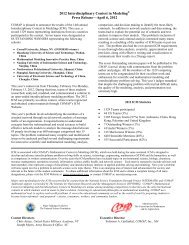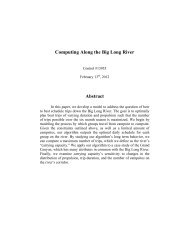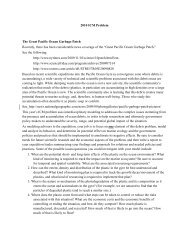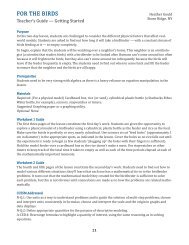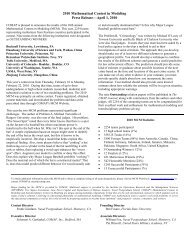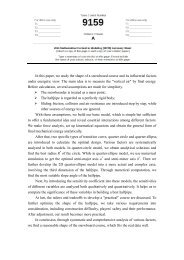Centroids, Clusters and Crime: Anchoring the Geographic Profiles of ...
Centroids, Clusters and Crime: Anchoring the Geographic Profiles of ...
Centroids, Clusters and Crime: Anchoring the Geographic Profiles of ...
You also want an ePaper? Increase the reach of your titles
YUMPU automatically turns print PDFs into web optimized ePapers that Google loves.
Team # 7507 Page 17<br />
(Gaussian or negative exponential) over each crime site. The sum <strong>of</strong> <strong>the</strong>se produce a surface<br />
<strong>of</strong> likely home sites (CGT Method)[15]. This method is more effective for determining likely<br />
anchor point locations because it assigns values <strong>of</strong> ‘likelihood’ over <strong>the</strong> entire search, as opposed<br />
to <strong>the</strong> centroid method which gives one anchor point location. Since we use <strong>the</strong> centroid<br />
only as a step to predicting crime locations (<strong>and</strong> not as a method for searching anchor points)<br />
<strong>the</strong> singular output <strong>of</strong> <strong>the</strong> centroid approach makes more sense to use in our algorithm.<br />
7.1.3 Building a Likelihood Crater<br />
With <strong>the</strong> estimate <strong>of</strong> an anchor point location, we now predict future crime locations using<br />
<strong>the</strong> “journey-to-crime” model within serial killer psychology. Again, this says that <strong>the</strong> serial<br />
criminal’s spatial pattern <strong>of</strong> crime around an anchor point, in general, does not change. For<br />
example, if a serial rapist commits his crimes 120 meters away from his home, on average, we<br />
can predict that he will likely strike again within this distance from his home[17]. A rough <strong>and</strong><br />
first pass prediction discussed in Paulsen’s 2005 conference proceedings might be to draw a<br />
large shape (circle, square, polygon, etc) around this anchor point based on <strong>the</strong> largest distance<br />
from a crime point to <strong>the</strong> anchor point. This prediction method was shown to be incredibly<br />
ineffective against <strong>the</strong> largest circle guess described in <strong>the</strong> background[11].<br />
We instead use a more effective cratering technique first described in a home find algorithm<br />
by Rossmo. To do this, <strong>the</strong> two dimensional crime points x i are mapped to <strong>the</strong>ir radius from<br />
<strong>the</strong> anchor point a i i.e. f : x i → r i where f(x i )=‖x i − a i ‖ 2 (a shifted modulus). The set r i<br />
is <strong>the</strong>n used to generate a crater around <strong>the</strong> anchor point.<br />
There are two dominating <strong>the</strong>ories for <strong>the</strong> pattern serial crimes follow around an anchor<br />
point. The first says that <strong>the</strong>re should be a buffer zone around <strong>the</strong> anchor point. A serial criminal,<br />
according to this <strong>the</strong>ory, will commit crimes in an annulus centered at <strong>the</strong> anchor point[8].<br />
This <strong>the</strong>ory alone is <strong>of</strong>ten modeled using <strong>the</strong> positive portion <strong>of</strong> a Gaussian curve with parameters<br />
mean <strong>and</strong> variance <strong>of</strong> {r i }. The o<strong>the</strong>r <strong>the</strong>ory says that crimes follow a decaying exponential<br />
pattern from <strong>the</strong> attractor point. Both <strong>the</strong>ories have been substantiated by analysis on journey<br />
to crime research. Yet we seek a distribution that would model ei<strong>the</strong>r <strong>the</strong>ory, depending on <strong>the</strong><br />
patterns displayed in <strong>the</strong> crime sequence. For this we turn to <strong>the</strong> flexibility <strong>of</strong> <strong>the</strong> Γ-distribution.<br />
Hogg et. al. note that <strong>the</strong> probability density function (pdf) for <strong>the</strong> Γ-distribution is a good<br />
model “for many nonnegative r<strong>and</strong>om variables <strong>of</strong> <strong>the</strong> continuous type” due to <strong>the</strong> two flexible<br />
parameters[5]. The Γ-distribution provides a compelling shape for our model: it <strong>of</strong>fers a<br />
“shifted-Gaussian” like behavior when points lie fur<strong>the</strong>r away <strong>and</strong> a curve similar to a negative<br />
exponential when <strong>the</strong> parameters are small. Figure 3 displays two plots demonstrating <strong>the</strong><br />
flexibility <strong>of</strong> <strong>the</strong> shape <strong>of</strong> <strong>the</strong> Γ-distribution.







